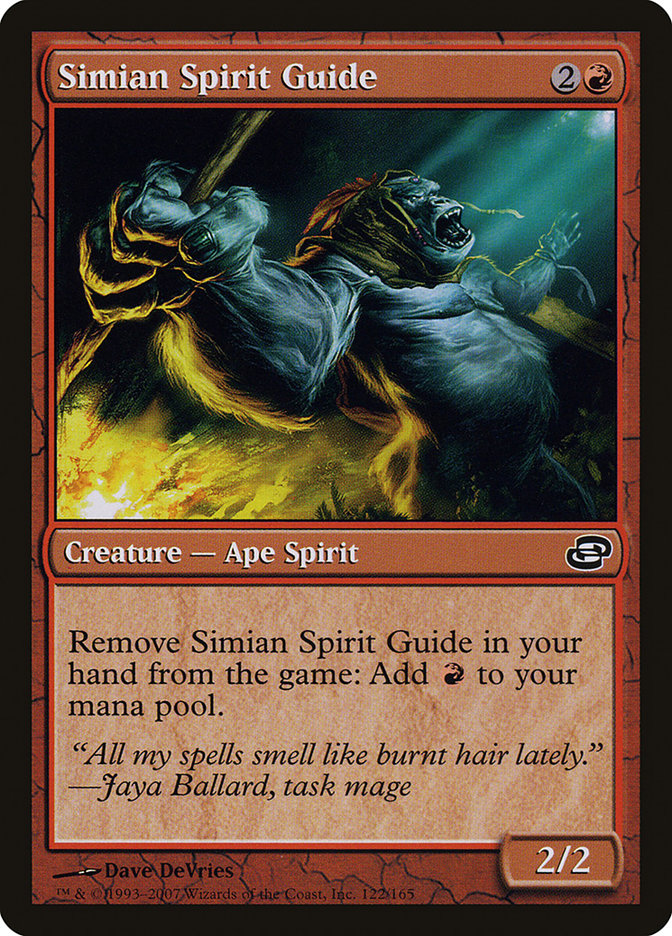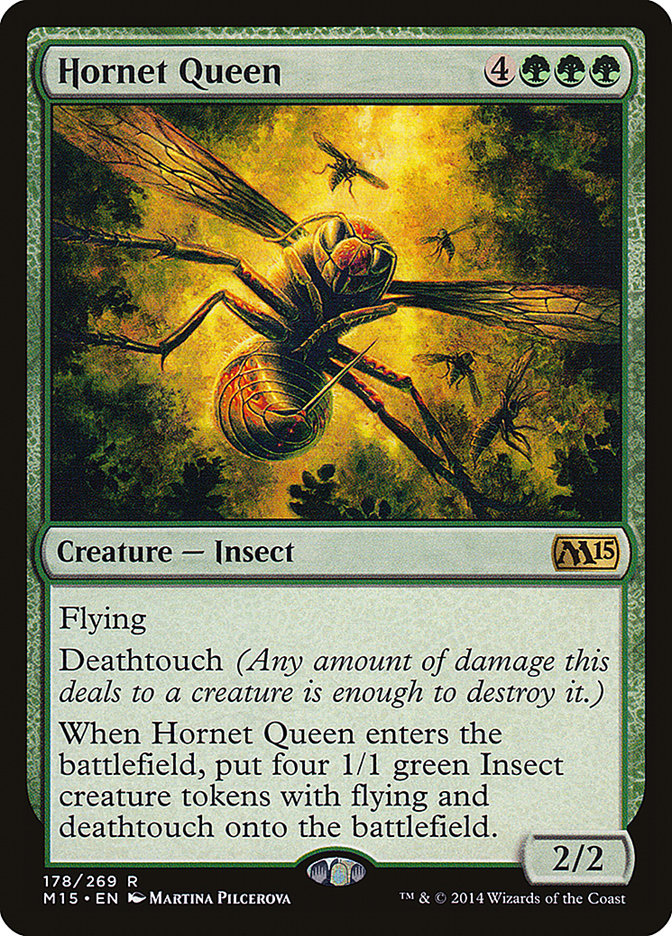In the wake of the Season Two Invitational in Columbus, I opted to run back Amulet Bloom at Grand Prix Charlotte. I knew that there was a possibility that the format could have a knee-jerk reaction to Amulet Bloom and G/R Tron, but I felt that it was more likely that people would just stick to what they had already been playing.
The hate cards also don’t really translate well across the matchups, outside of Fulminator Mage. Blood Moon is fantastic against Amulet Bloom, but it’s not a knock-out punch against G/R Tron at all.
Over the course of the Season Two Invitational, I felt like I was always one mana short of doing a lot of things, especially in the sideboard games against decks with Ghost Quarter and Fulminator Mage. This feeling combined with the few talks that I had with Matthias Hunt about the deck led me to give Simian Spirit Guide a try. I know that most people have always just kept the one Simian Spirit Guide that Justin Cohen played at the Pro Tour, but I was initially not very impressed with it.
For Grand Prix Charlotte I wanted to give it another shot, but this time I wanted to try more. I knew that I wanted to be on two or three copies, but I couldn’t really decide. I wanted to find room for a second basic land in the deck as well, and after chatting with Justin Cohen about the deck I found out he was playing a second basic in the sideboard. This actually sounded really good since we mainly wanted it against decks with a lot of Ghost Quarters and against decks that might be bringing in Blood Moon against us.
I ended up putting the Ghost Quarter in the maindeck and cut the second Cavern of Souls for it. Over the course of the event I wished that I had access to a second Cavern of Souls a few times, but that was mainly due to the fact that I was paired against multiple Jeskai Control decks and even U/B Faeries.
Here is the list I ended up on that went 11-4 and placed in the Top 100 for a couple hundred bucks and a Pro Point:
Creatures (7)
Lands (27)
Spells (26)

The deck performed admirably, and I could have easily ended up at 13-2. Two of my losses were to Jund and Burn, which are both very good matchups. I made very poor mulligan decisions in both matches and was a single card away from winning multiple times in both. Against Burn on the draw, I even had a potential straight-up turn-one Primeval Titan in game one. Simian Spirit Guide, Amulet of Vigor, bounceland, and Summer Bloom along with a Gemstone Mine and a Serum Visions. It basically was the perfect hand. I ended up dying on turn four or so after never drawing a Primeval Titan or Summoner’s Pact.
Unfortunately I don’t have a whole lot of Modern coming up so I’m going to have to say goodbye to Amulet Bloom for now, but if you are planning on battling in any of the Modern 5K Premier IQs during an Open Series weekend or in any of your local IQs and you’re interested in picking up Amulet Bloom, I would suggest playing a lot of games with it. There are so many intricacies with the different lines that you’re really only going to learn the deck by playing matches with it.
Coming up next, though, we have Standard, Standard, and more Standard! With the Open Series coming to Indianapolis and a Grand Prix in Providence featuring the format this weekend, we’ve got to get back to our Stormbreath Dragons,
At the Season Two Invitational, I ended up on G/R Devotion along with Brad and BBD, but I’m not so sure if that’s where I want to be moving forward. With the great showing that the deck had at the Invitational, I have to imagine that it’s going to be public enemy number one as we move into Season Three, but what exactly does that mean?
G/R Devotion is well-equipped to battle against the different flavors of Abzan in addition to things like G/R Dragons and aggressive Red decks, but it is poorly-positioned against Esper Dragons and U/B Control. I think it might be safe to say that we could likely see an uptick in Esper Dragon decks which could spell doom for a Sylvan Caryatid lover such as myself.
I think, though, that the best bet for me is going to be just saying “screw it” and playing whatever it is that I want to play. I feel like we all somehow seem to have forgotten about Goblin Rabblemaster and it might be poised for a return. Jeff Hoogland recently won the Standard Premier IQ in Columbus at the Season Two Invitational with a Mardu Aggro deck that seems pretty interesting, but much like the Mardu decks of old, I’m not too excited about sideboarding into a control deck with Elspeth, Sun’s Champion and only 25 lands.
If you know anything about me by now, it’s that I love me some Dragons. Thunderbreak Regent and Stormbreath Dragon are both fabulous, and I think that I want to try out an aggressive G/R Dragons deck utilizing Goblin Rabblemaster. Getting the “nut” draw of putting a Goblin Rabblemaster onto the battlefield on turn two happens a decent amount of the time, and when you add in just how much incidental damage we can get with Draconic Roar we can put the game away fairly quickly.
Let’s take a look at one possibility.
Creatures (26)
- 4 Elvish Mystic
- 4 Stormbreath Dragon
- 3 Boon Satyr
- 4 Goblin Rabblemaster
- 4 Rattleclaw Mystic
- 4 Thunderbreak Regent
- 3 Den Protector
Planeswalkers (2)
Lands (24)
Spells (8)
Sideboard

I like the idea of utilizing Boon Satyr as a way to make our Den Protectors great attackers. When I was playing a version of G/R Dragons with two Den Protectors in them, I cast them as a 2/1 for 1G a surprising amount of the time. Boon Satyr also does some pretty good work with Bestowing onto a Goblin Rabblemaster, or even onto a Thunderbreak Regent or Stormbreath Dragon. Being a flash threat against the control decks is also a pretty big bonus for Boon Satyr.
The biggest drawback to playing something a bit more aggressive like this is that we no longer have access to Dragonlord Atarka. We could potentially try to fit her in the deck, but by moving away from Sylvan Caryatid and Courser of Kruphix to Rattleclaw Mystic and Goblin Rabblemaster we no longer have a resilient mana accelerant and the land-smoothing effect from Courser of Kruphix.
Not having access to Dragonlord Atarka means that we are quite weak to Hornet Queen, and with the resurgence of G/R Devotion that might be a risky proposition. We do address this with things like Barrage of Boulders out of the sideboard, but it’s still a pretty rough card to beat.
She’s pretty tough to beat right now.
For those of you who are set on the G/R Devotion train, I would suggest to be prepared for the mirror and control decks. The mirror is really all about breaking serve with Xenagos, the Reveler if you aren’t able to put a Whisperwood Elemental onto the battlefield on turn three and run away with the game. When I played the mirror at the Invitational, it really felt like having an Elvish Mystic was absurdly important and whoever got Xenagos, the Reveler onto the battlefield first had a huge advantage. Since Xenagos is also great against the control decks, I think that I would definitely be on a full four copies of Xenagos, the Reveler for this week.
The card that I was least impressed with was Deathmist Raptor. I think that it’s great against Esper Dragons, but I could totally see myself cutting it. I think that we still want access to a couple more three-drops, and since we already have Rattleclaw Mystic and a Den Protector in the sideboard it makes sense to keep a few Deathmist Raptors around.
To be honest, I don’t even think that the G/R Dragons deck I played shortly after Syracuse is even all that bad against Esper Dragons. It’s not favorable for us, sure, but with the right draws the deck is almost unbeatable and in a wide-open field like what we can expect at a Grand Prix or an Open, playing something that’s great against the field is often a very powerful strategy.
One of the decks that did perform well at the Invitational was Bant Heroic. There were quite a few that were in the running for Top Eight, and I had to get very lucky to beat it in my final round of the tournament. Since it really is only weak to the different Abzan decks, if we expect there to be a lot of G/R Devotion and Esper Dragons coming up then playing Bant Heroic might actually be a good call. The downside, though, is that if people still decide to show up with their tried-and-true Abzan decks we might be in for a bad time.
Trying to figure out this Standard format really is quite dazzling. Round and round in circles we go, where it ends up, nobody knows.
Basically it boils down to the following:
- Abzan beats Bant Heroic and Esper Control
- Bant Heroic beats Esper Control and G/R Devotion
- G/R Devotion beats Abzan and most other decks
- Esper Control beats G/R Devotion but is soft to a lot of decks
When I step back and look at the format, there really are three things that I want to be doing.
- Play Hornet Queen or Stormbreath Dragon
- Play Xenagos, the Reveler, and/or other planeswalkers
- Dodge Bant Heroic
With that checklist I will likely end up on G/R Devotion or G/R Dragons again (like anyone would be surprised anyway), but I’d like to know what you think I should play.
Dragons?
Devotion?
Other?! (I like being open-minded, but I mean, we all know it’s gonna be between the other two)


